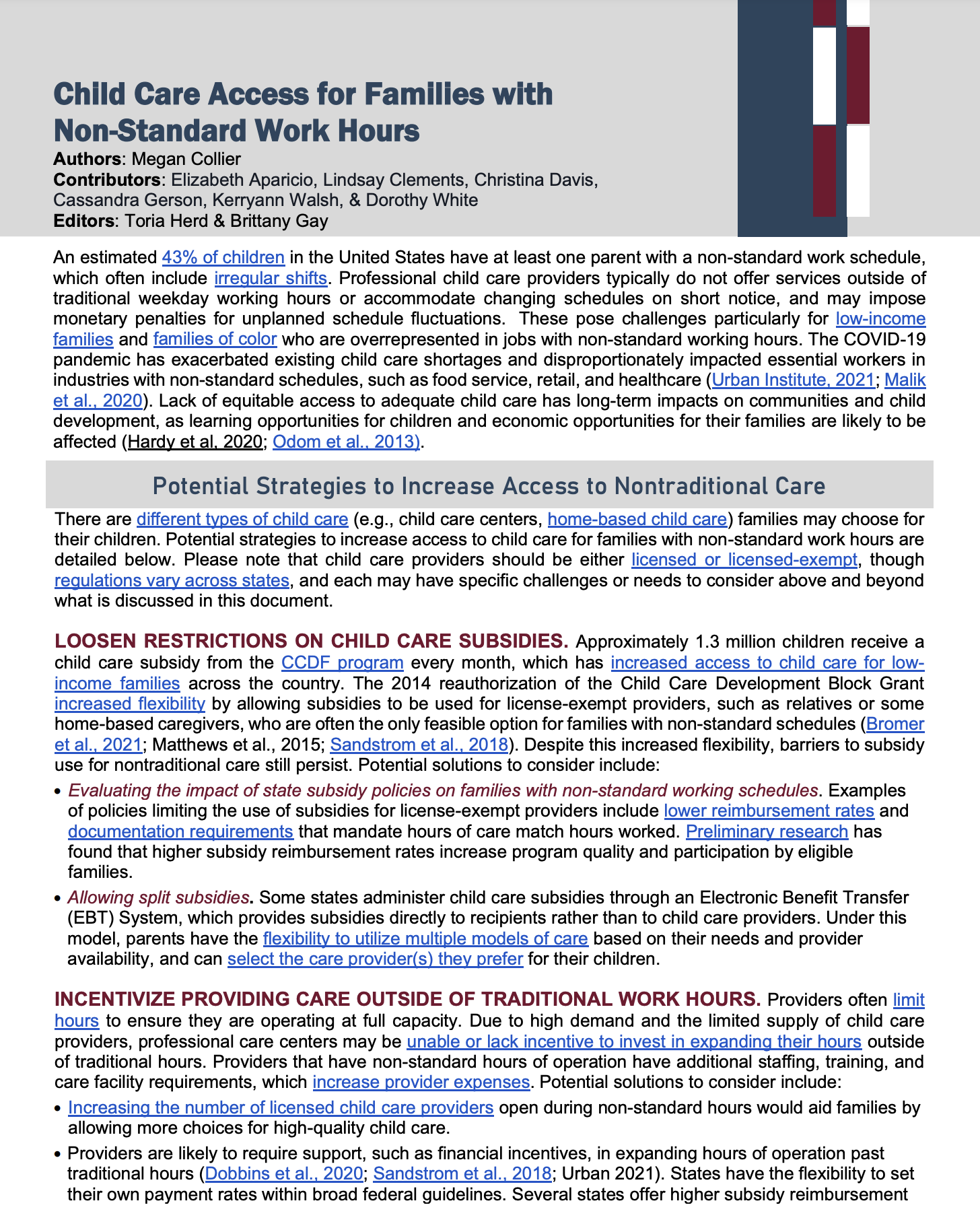
An estimated 43% of children in the United States have at least one parent with a non-standard work schedule, which often include irregular shifts. Professional child care providers typically do not offer services outside of traditional weekday working hours or accommodate changing schedules on short notice, and may impose monetary penalties for unplanned schedule fluctuations. These pose challenges particularly for low-income families and families of color who are overrepresented in jobs with non-standard working hours. The COVID-19 pandemic has exacerbated existing child care shortages and disproportionately impacted essential workers in industries with non-standard schedules, such as food service, retail, and healthcare (Urban Institute, 2021; Malik et al., 2020). Lack of equitable access to adequate child care has long-term impacts on communities and child development, as learning opportunities for children and economic opportunities for their families are likely to be affected (Hardy et al, 2020; Odom et al., 2013).
Potential Strategies to Increase Access to Nontraditional Care
There are different types of child care (e.g., child care centers, home-based child care) families may choose for their children. Potential strategies to increase access to child care for families with non-standard work hours are detailed below. Please note that child care providers should be either licensed or licensed-exempt, though regulations vary across states, and each may have specific challenges or needs to consider above and beyond what is discussed in this document.
Loosen Restriction on Child Care Subsidies.
Approximately 1.3 million children receive a child care subsidy from the CCDF program every month, which has increased access to child care for low-income families across the country. The 2014 reauthorization of the Child Care Development Block Grant increased flexibility by allowing subsidies to be used for license-exempt providers, such as relatives or some home-based caregivers, who are often the only feasible option for families with non-standard schedules (Bromer et al., 2021; Matthews et al., 2015; Sandstrom et al., 2018). Despite this increased flexibility, barriers to subsidy use for nontraditional care still persist. Potential solutions to consider include:
- Evaluating the impact of state subsidy policies on families with non-standard working schedules. Examples of policies limiting the use of subsidies for license-exempt providers include lower reimbursement rates and documentation requirements that mandate hours of care match hours worked. Preliminary research has found that higher subsidy reimbursement rates increase program quality and participation by eligible families.
- Allowing split subsidies. Some states administer child care subsidies through an Electronic Benefit Transfer (EBT) System, which provides subsidies directly to recipients rather than to child care providers. Under this model, parents have the flexibility to utilize multiple models of care based on their needs and provider availability, and can select the care provider(s) they prefer for their children.
Incentive Providing Care Outside of Traditional Work Hours.
Providers often limit hours to ensure they are operating at full capacity. Due to high demand and the limited supply of child care providers, professional care centers may be unable or lack incentive to invest in expanding their hours outside of traditional hours. Providers that have non-standard hours of operation have additional staffing, training, and care facility requirements, which increase provider expenses. Potential solutions to consider include:
- Increasing the number of licensed child care providers open during non-standard hours would aid families by allowing more choices for high-quality child care.
- Providers are likely to require support, such as financial incentives, in expanding hours of operation past traditional hours (Dobbins et al., 2020; Sandstrom et al., 2018; Urban 2021). States have the flexibility to set their own payment rates within broad federal guidelines. Several states offer higher subsidy reimbursement rates for child care provided during non-standard hours (Sosinsky 2020; Mathematica, 2019); however, the impact of these increased rates has not been formally evaluated.
Increase Access to High-quality Care.
Although quality standards can vary from state to state, in general, high quality of care has a significant positive effect on healthy childhood development (Bradley & Vandell, 2007; Sosinksy, 2020). License-exempt providers and home-based providers, which may or may not be license-exempt, are often the only option for many families with non-standard working schedules. However, quality is often less regulated in these settings and they are often not required to follow the same health, safety, or curricular standards as professional providers. One barrier to increasing high quality care by license-exempt caregivers is the lack of caregivers’ access to training and other resources to provide such care. An additional barrier is that indicators of quality in child care settings are typically based on daytime care and often do not take into account some of the unique needs of children in evening or overnight care. Potential solutions to consider include:
- Providing assistance to families in identifying and accessing high-quality professional providers. Parent navigator programs and child care help lines are active in several states and help parents find care that suits their schedules. One example of this is Indiana’s Paths to QUALITY, which helps families find quality licensed providers that offer care during nontraditional hours. 22% of participating providers report offering care during nontraditional hours.
- Expanding quality indicators for caregiving during nontraditional hours to ensure equitable standards for licensed and license-exempt providers. Educational standards, for example, in center-based care have been associated with better cognitive, developmental, and school readiness outcomes.
- Creating pathways to increase the quality of unlicensed child care. For example, in Michigan’s Quality Improvement Pilot Program, 280 providers completed 10 hours of training and became eligible to receive tiered reimbursement from the state’s Child Development and Care program after meeting quality standards.
Support Workplace Efforts to Aid Families.
Workplaces can support families’ access to child care through scheduling practices (e.g., providing workers with predictable schedules, providing exclusions for mandatory overtime) and, if resources are available, providing onsite childcare options to their employees. Irregular scheduling poses a significant challenge to child care access for families with non-standard hours. Increasing the predictability of work schedules and number of hours may increase families’ ability to schedule care and secure subsidy reimbursement. Potential solutions to consider include:
- Implementing policies that increase the predictability of work schedules.
- Philadelphia’s Fair Work Week ordinance requires employers in industries such as food and retail to provide employees with their schedules at least two weeks in advance (Sosinsky, 2020).
- Seattle passed a similar law in 2016 to support workers with non-standard hours, establishing employer requirements such as advance notice of work schedules, compensation for any last-minute changes, and providing employees with a reliable estimation of the number of hours they will regularly work.
- Create child care options through employers to meet the needs of non-standard schedule workers. Examples of these include:
- Military Child Care Fee Assistance Programs: Child care on military bases is federally subsidized and accommodates fluctuating schedules. On average, service members spend 16% less of their income on child care than families nationally, and 97% of military centers are independently certified as high-quality, compared to less than 10% of civilian centers.
- Toyota Night Care: Toyota provides on-site child care at manufacturing facilities in the Midwest and at select locations around the world to accommodate early morning and overnight child care needs.
Although access to child care can be especially limited for parents with nontraditional work schedules, strategies to increase access to child care for these families exist. Further policy recommendations for increasing access to quality child care can be found in this fact sheet.
The Research-to-Policy Collaboration (RPC) works to bring together research professionals and public officials to support evidence-based policy. Please visit their website to learn more.
Key Information
RPC Website
Research-to-Policy Collaboration
Publication DateNovember 12, 2021
Topic Area(s)Social Services, Economy and Entrepreneurship
Resource TypeWritten Briefs
Share This Page
An estimated 43% of children in the United States have at least one parent with a non-standard work schedule, which often include irregular shifts. Professional child care providers typically do not offer services outside of traditional weekday working hours or accommodate changing schedules on short notice, and may impose monetary penalties for unplanned schedule fluctuations. These pose challenges particularly for low-income families and families of color who are overrepresented in jobs with non-standard working hours. The COVID-19 pandemic has exacerbated existing child care shortages and disproportionately impacted essential workers in industries with non-standard schedules, such as food service, retail, and healthcare (Urban Institute, 2021; Malik et al., 2020). Lack of equitable access to adequate child care has long-term impacts on communities and child development, as learning opportunities for children and economic opportunities for their families are likely to be affected (Hardy et al, 2020; Odom et al., 2013).
Potential Strategies to Increase Access to Nontraditional Care
There are different types of child care (e.g., child care centers, home-based child care) families may choose for their children. Potential strategies to increase access to child care for families with non-standard work hours are detailed below. Please note that child care providers should be either licensed or licensed-exempt, though regulations vary across states, and each may have specific challenges or needs to consider above and beyond what is discussed in this document.
Loosen Restriction on Child Care Subsidies.
Approximately 1.3 million children receive a child care subsidy from the CCDF program every month, which has increased access to child care for low-income families across the country. The 2014 reauthorization of the Child Care Development Block Grant increased flexibility by allowing subsidies to be used for license-exempt providers, such as relatives or some home-based caregivers, who are often the only feasible option for families with non-standard schedules (Bromer et al., 2021; Matthews et al., 2015; Sandstrom et al., 2018). Despite this increased flexibility, barriers to subsidy use for nontraditional care still persist. Potential solutions to consider include:
- Evaluating the impact of state subsidy policies on families with non-standard working schedules. Examples of policies limiting the use of subsidies for license-exempt providers include lower reimbursement rates and documentation requirements that mandate hours of care match hours worked. Preliminary research has found that higher subsidy reimbursement rates increase program quality and participation by eligible families.
- Allowing split subsidies. Some states administer child care subsidies through an Electronic Benefit Transfer (EBT) System, which provides subsidies directly to recipients rather than to child care providers. Under this model, parents have the flexibility to utilize multiple models of care based on their needs and provider availability, and can select the care provider(s) they prefer for their children.
Incentive Providing Care Outside of Traditional Work Hours.
Providers often limit hours to ensure they are operating at full capacity. Due to high demand and the limited supply of child care providers, professional care centers may be unable or lack incentive to invest in expanding their hours outside of traditional hours. Providers that have non-standard hours of operation have additional staffing, training, and care facility requirements, which increase provider expenses. Potential solutions to consider include:
- Increasing the number of licensed child care providers open during non-standard hours would aid families by allowing more choices for high-quality child care.
- Providers are likely to require support, such as financial incentives, in expanding hours of operation past traditional hours (Dobbins et al., 2020; Sandstrom et al., 2018; Urban 2021). States have the flexibility to set their own payment rates within broad federal guidelines. Several states offer higher subsidy reimbursement rates for child care provided during non-standard hours (Sosinsky 2020; Mathematica, 2019); however, the impact of these increased rates has not been formally evaluated.
Increase Access to High-quality Care.
Although quality standards can vary from state to state, in general, high quality of care has a significant positive effect on healthy childhood development (Bradley & Vandell, 2007; Sosinksy, 2020). License-exempt providers and home-based providers, which may or may not be license-exempt, are often the only option for many families with non-standard working schedules. However, quality is often less regulated in these settings and they are often not required to follow the same health, safety, or curricular standards as professional providers. One barrier to increasing high quality care by license-exempt caregivers is the lack of caregivers’ access to training and other resources to provide such care. An additional barrier is that indicators of quality in child care settings are typically based on daytime care and often do not take into account some of the unique needs of children in evening or overnight care. Potential solutions to consider include:
- Providing assistance to families in identifying and accessing high-quality professional providers. Parent navigator programs and child care help lines are active in several states and help parents find care that suits their schedules. One example of this is Indiana’s Paths to QUALITY, which helps families find quality licensed providers that offer care during nontraditional hours. 22% of participating providers report offering care during nontraditional hours.
- Expanding quality indicators for caregiving during nontraditional hours to ensure equitable standards for licensed and license-exempt providers. Educational standards, for example, in center-based care have been associated with better cognitive, developmental, and school readiness outcomes.
- Creating pathways to increase the quality of unlicensed child care. For example, in Michigan’s Quality Improvement Pilot Program, 280 providers completed 10 hours of training and became eligible to receive tiered reimbursement from the state’s Child Development and Care program after meeting quality standards.
Support Workplace Efforts to Aid Families.
Workplaces can support families’ access to child care through scheduling practices (e.g., providing workers with predictable schedules, providing exclusions for mandatory overtime) and, if resources are available, providing onsite childcare options to their employees. Irregular scheduling poses a significant challenge to child care access for families with non-standard hours. Increasing the predictability of work schedules and number of hours may increase families’ ability to schedule care and secure subsidy reimbursement. Potential solutions to consider include:
- Implementing policies that increase the predictability of work schedules.
- Philadelphia’s Fair Work Week ordinance requires employers in industries such as food and retail to provide employees with their schedules at least two weeks in advance (Sosinsky, 2020).
- Seattle passed a similar law in 2016 to support workers with non-standard hours, establishing employer requirements such as advance notice of work schedules, compensation for any last-minute changes, and providing employees with a reliable estimation of the number of hours they will regularly work.
- Create child care options through employers to meet the needs of non-standard schedule workers. Examples of these include:
- Military Child Care Fee Assistance Programs: Child care on military bases is federally subsidized and accommodates fluctuating schedules. On average, service members spend 16% less of their income on child care than families nationally, and 97% of military centers are independently certified as high-quality, compared to less than 10% of civilian centers.
- Toyota Night Care: Toyota provides on-site child care at manufacturing facilities in the Midwest and at select locations around the world to accommodate early morning and overnight child care needs.
Although access to child care can be especially limited for parents with nontraditional work schedules, strategies to increase access to child care for these families exist. Further policy recommendations for increasing access to quality child care can be found in this fact sheet.
The Research-to-Policy Collaboration (RPC) works to bring together research professionals and public officials to support evidence-based policy. Please visit their website to learn more.

Key Information
RPC Website
Research-to-Policy Collaboration
Publication DateNovember 12, 2021
Topic Area(s)Social Services, Economy and Entrepreneurship
Resource TypeWritten Briefs
Share This Page
LET’S STAY IN TOUCH
Join the Evidence-to-Impact Mailing List
Keep up to date with the latest resources, events, and news from the EIC.




